The ULTIMATE Hummingbirds Trip,
and the Birds
and
Wildlife of Ecuador
Photo Tour
Dates: April 30-May 13, 2024
Price: $ 7,295
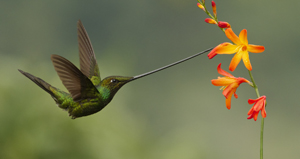
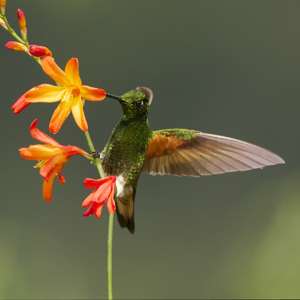
.jpg)
Optional Extension to the Amazon
May 13-18, 2024
Price: $4,595
Sani Lodge
We'll be offering a six-day extension (5 nights at the lodge) for photographing and observing the wildlife of the Amazon. There's a tower for canopy-level viewing, night walks for nocturnal wildlife, and boating trips for water birds and wildlife. There is also a nearby Parrot clay lick where scores, if not hundreds, of various parrot species visit daily. Click on the link above for more details, also available at the end of this brochure.
Check out the videos:
Hummingbirds and Wildlife of Ecuador Photo Tour
Hummingbird Video Portfolio
We've added several new shooting locations for this tour,
for more hummingbirds, birds, and wildlife!
We'll be visiting 9 different locations (many are day trips from our base) for the greatest variety of hummingbirds and other species.
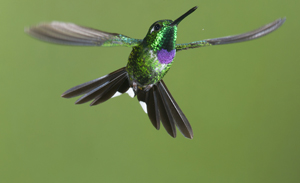
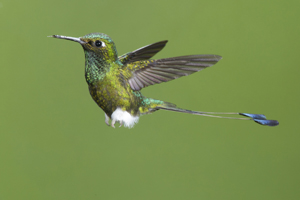
Hummingbirds are the primary 'focus' of this trip and
Ecuador has an incredible variety!
You will be using our High Speed Flash for the Hummingbird set-ups
as you photograph Hummers and learn how to use high speed flash!
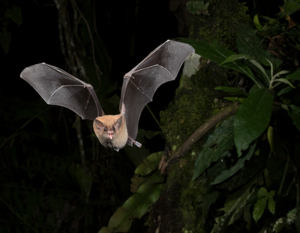
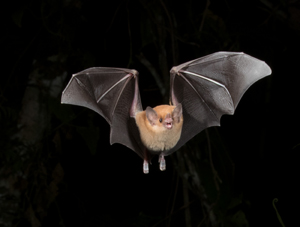
Weather permitting, you will also have the opportunity to photograph
flying bats with our high speed flash setups.
Limited to 5 Participants
Everyone rotates through all
of our high-speed flash sets - no down time!
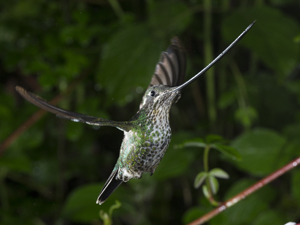
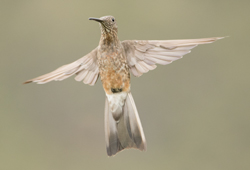
Sword-billed Hummingbird - one of the most unique of all Hummers
and something you have to see to really believe! At our new, added location, you will
photograph the world's largest hummingbird, the Giant, and other species.
Incredible Hummingbird Photography using our High Speed Flash set-ups characterize this exciting tour to one of the
most accessible and rewarding wildlife destinations for Hummingbirds and other birds and wildlife in the cloud forests and upper Amazon Basin of Ecuador!
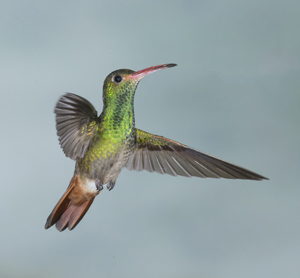
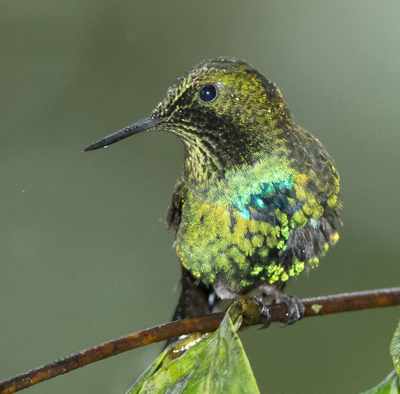
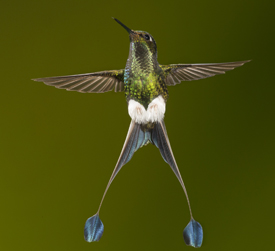
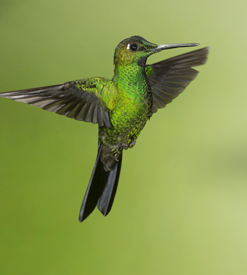
Although our primary subject will be Hummingbirds, we'll be shooting a variety of other bird species, landscapes, amphibians, and mammals at several different locations. At several of our hummingbird locations participants will be using our Flash systems to ensure razor-sharp, exciting, dynamic photographs, requiring you to do nothing more than tweak an exposure if necessary and focus!
We will have Four high-speed Flash Set-ups at our major hummingbird shooting location, meaning that when we are shooting hummingbirds four people will have their own set while one person has time to download and charge batteries. We rotate everyone through all of the hummingbird sets, ensuring that you'll have the greatest chance of catching all the action -- no matter which feeder is most active.
No other tour offers this type of accessibility and opportunity.
Ecuador's Hummingbirds are incredibly diverse, and you're likely to photograph well over twenty species, including the spectacular Swordbill and the charming Booted Racquet-tail, almost everyone's favorite. On our 2016 tour we photographed over 30 different species of hummingbird - check our trip report! For our 2018 tour we saw and photographed as many as 40 species! Read the Trip Report 2018. In 2022 we had nearly 50 species!
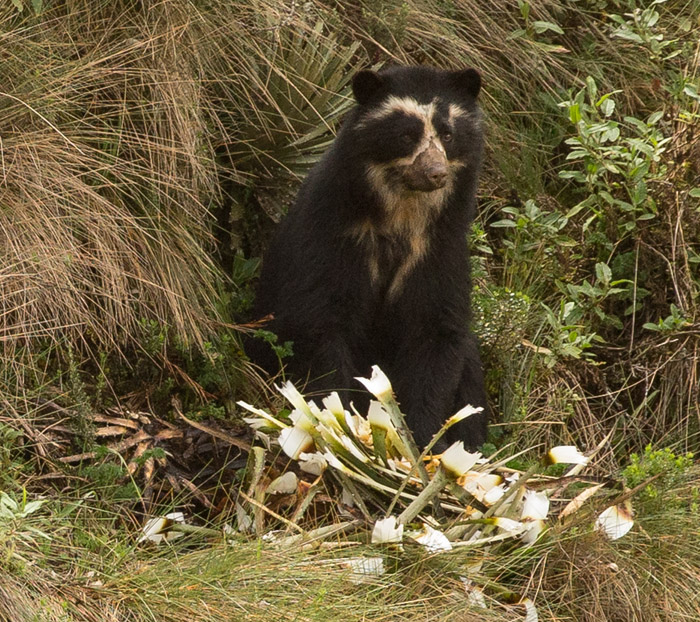
Spectacled Bear - The only bear found in South America and the second rarest bear in the world. Our group photographed this bear on our 2016 tour. Read about that tour to have a great idea of what our tours are like and what you too can hope to photograph!
We'll be basing our stay at several very diverse locations, where we'll be doing most of our shooting and also that we will be using as a base as we do side-trips for particular birds or mammals.
Trip Highlights
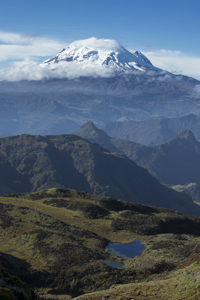 Located on the Equator, Ecuador is a beautiful, stable, and diverse country, with an incredible variety of Hummingbirds and other bird species. We'll be based at several lodges, including one in Ecuador's cloud forest, one at the base of the Andies in transitional forest where alpine species like Torrent Ducks and Dippers live adjacent to the forest and subtropical Hummingbirds, and one in the upper reaches of the Amazon Basin, where true tropical forest birds and mammals and frogs and treefrogs are found.
Located on the Equator, Ecuador is a beautiful, stable, and diverse country, with an incredible variety of Hummingbirds and other bird species. We'll be based at several lodges, including one in Ecuador's cloud forest, one at the base of the Andies in transitional forest where alpine species like Torrent Ducks and Dippers live adjacent to the forest and subtropical Hummingbirds, and one in the upper reaches of the Amazon Basin, where true tropical forest birds and mammals and frogs and treefrogs are found.
Additionally, in the highlands where, weather permitting, we'll spend a wonderful morning photographing snow-capped volcanoes at our highest elevation of the trip, we may also encounter South America's only bear, the Spectacled Bear.
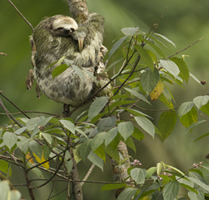
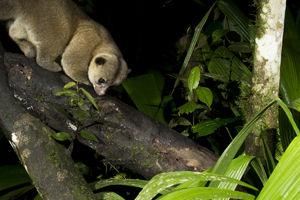
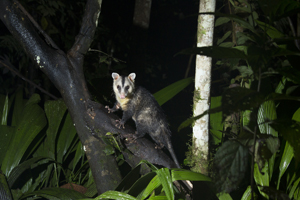
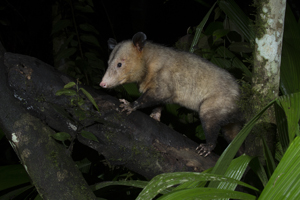
Although mammal activity is rather limited, except at our third shooting location, we have photographed Three-toed Sloths, Olinquita, and Opossums at our various locations. For anyone interested, and who brings the correct equipment, you would have the opportunity for remote, unmanned photography of the nocturnal mammals.
At our last destination, in the upper reaches of the Amazon basin, we may have the opportunity to photograph a few primates (the Napo Tamarin is almost a definite), in addition to the tropical birds visiting the feeders.
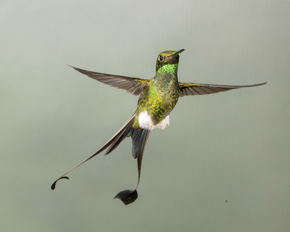
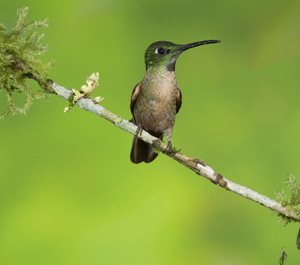
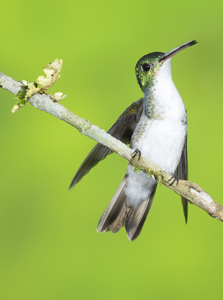
We'll also be shooting birds as they visit traditional feeders, where we won't worry whether or not a feeder shows in the image. Sometimes simple cropping can eliminate a feeder, but I'll be showing you how to make unique, dynamic and original images as well, via Photoshop and Flower EXTRACTIONS that I will provide.
We'll also use sugar water-baited flowers, so you'll have a variety of options with your photography.
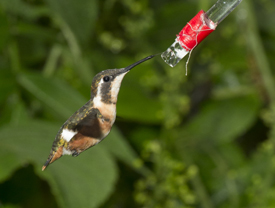
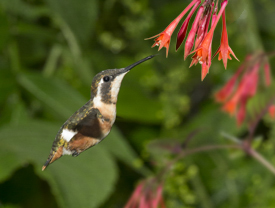
That's the exciting aspect of this tour, as we'll be doing a mini-Photoshop workshop on how you can composite images to maximize our shooting. While all of us would love to be able to shoot every hummingbird at a natural flower, time, cooperation, and opportunity precludes that wish every time. Via Photoshop, however, we can maximize our shooting opportunities!
I have an ebook that details how to do this which you'll receive via a free link to our ejunkie book selling site and we'll have an abridged version that you'll receive during the tour. With this information, anyone using Photoshop can easily add a flower!
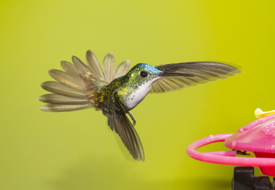
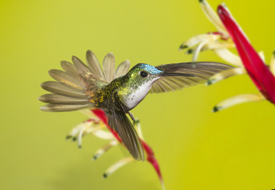
Some of the following images are composites, and some are straight shots.
Can you tell the difference?
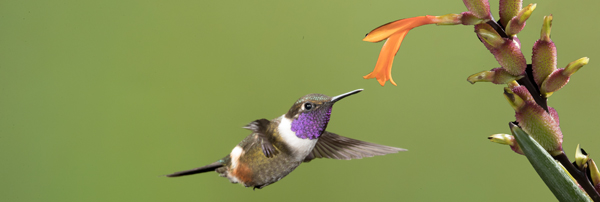
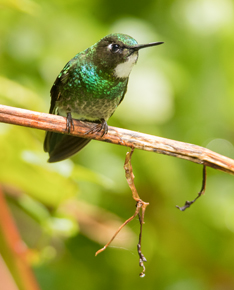
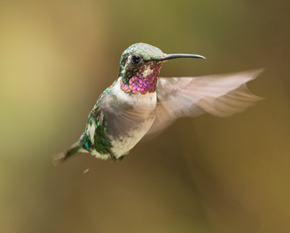
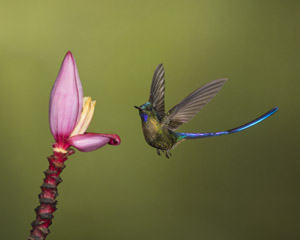
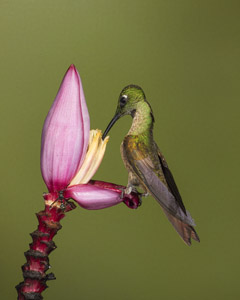
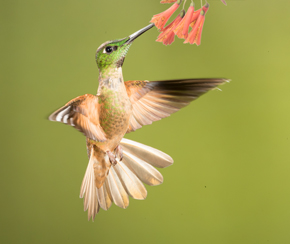
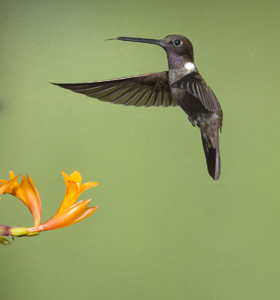
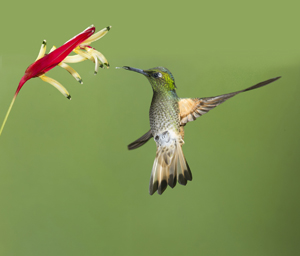
Our Various Locations
We will be visiting several great and quite diverse locations, without the inconvenience and the down-time that would be involved in changing lodges frequently. Instead, we'll be based at three locations, all terrific locations for bird and wildlife photography, and within easy driving distance of several other locations. The result -- a tremendous amount of diversity, including scenics, birds, frogs and treefrogs, and mammals. On the final day of the tour we'll head back to Quito and spend the night in a hotel near to the airport. The following morning we'll leave early for a daytrip into the higher elevations of the Antisana area. We'll be looking for a few new species of hummers as well as some other bird species that frequent this high altitude.
Our first Lodge

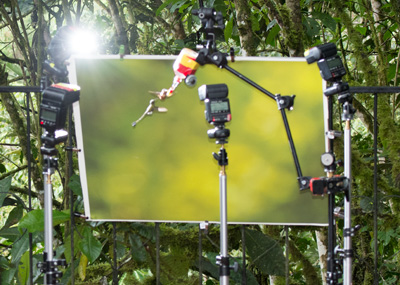
Three of our five set-ups are shown above. You'll be sitting comfortably at whatever distance you need for the lens you are using, although a 100-400, 70-300, or similar is perfect for these set-ups. Each set-up has four flashes, providing a variety of different lighting, and we have a variety of backgrounds as well.
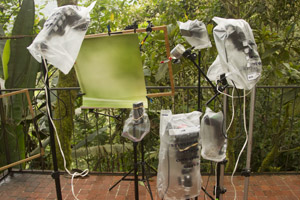
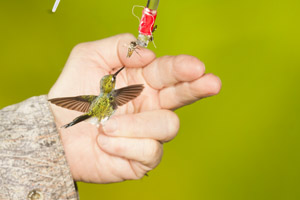
Although it is usually too uncomfortable to photograph in a heavy rain, we do shoot in drizzles -- which often do not last very long. The birds themselves are fearless!
We'll have four nights at one of the premier Hummingbird photography locations in the world. I'm not exaggerating when I say that hummers at our lodge's feeders are as thick as bees -- it is an incredible sight to see a half dozen species all swarming around a feeder.
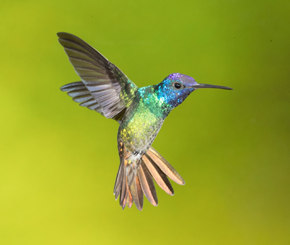
Of course, swarms of Hummingbirds are difficult to photograph, and we'll be setting up our special feeders and flowers nearby, siphoning off species that will make our photography easier, and more effective.
This Lodge will be our base for day-trips to three or four other locations, and you'll have plenty of time to photograph Hummingbirds from the comfort of the porches of the Lodge.
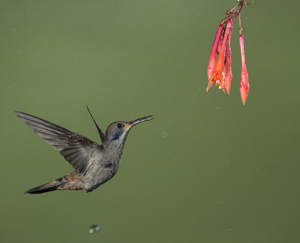


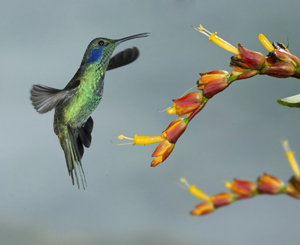

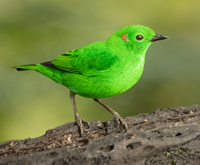 Some of our other locationso!
Some of our other locationso!
We'll do day trips to several other locations where we'll photograph Hummingbirds, Aracaris, Mot-Mots, and a variety of songbirds. We'll be in Three-toed Sloth country, and if we're lucky we'll get a good view, and great shots, of this interesting and often cryptic species.
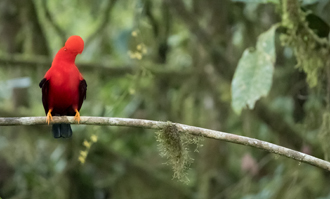
.jpg) The Lek
The Lek
One of the iconic species of the cloud forest is the spectacular Cock-of-the-Rock, a large pigeon-sized bird feathered in a golden orange plumage and topped by a sweeping crest that creates a distinctive and unique shape. We'll also be vsiting a ranch where a special viewing area/hide can provide spectacular shots.
Left, Photo by Judy Johnson
Guango Lodge
Guango is famous for the incredible Sword-bill Hummingbird, who sports a beak longer than its body. There are a variety of hummingbirds here, including several species, like the Chestnut-breasted Coronet, Collared Inca, Tourmaline Brilliant, and of course the Swordbill.The mountain stream that borders the property has White-capped Dippers, Torrent Ducks, and several forest birds. We'll have flashes set-up but some of the most productive shooting here has been with on-camera flash at the numerous feeders and perching areas. We'll be discussing how to balance flash and ambient light exposures for the most natural look.
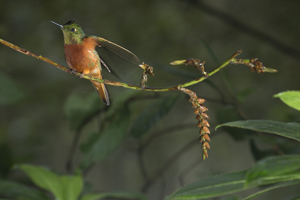
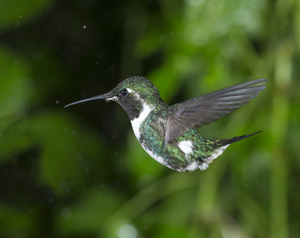
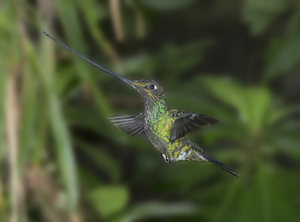
Papallacta Pass
We'll be in Spectacled Bear country, South America's only bear, and if the weather is clear, we'll be treated to spectacular views of snow-capped dormant volcanoes. Weather permitting, we'll spend a morning in this high country, looking for bears and endemic birds, and photographing the volcanoes. This visit is weather dependent, as rain or fog may make photographing or sighting wildlife impossible.
Antisana National Park
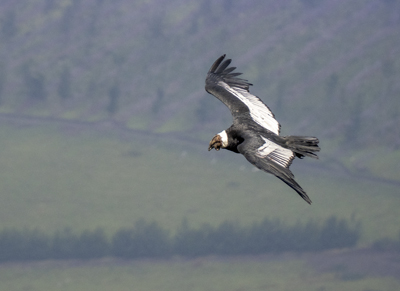 We'll be visiting the high altitudes outside Quito for Andean Condors and several new species of hummingbirds, as well as other species of birds.
We'll be visiting the high altitudes outside Quito for Andean Condors and several new species of hummingbirds, as well as other species of birds.
 Tamarin-16-5072.jpg) Upper Amazon basin
Upper Amazon basin
Our last location will be a beautiful lodge in the upper Amazon Basin. Treefrogs and frogs and other nocturnal subjects, including a variety of insects, are one of the highlights here, although there are a number of new Hummingbird species. We'll be photographing these species in natural light or with on-camera flash, which will also make our other bird and mammal photography more productive as well. Tamarins and the potential for some other jungle mammals, will be other subjects we'll be seeking.
As we visit several different locations, the variety of subjects seems endless...
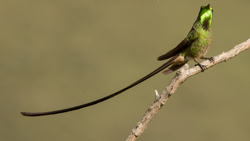
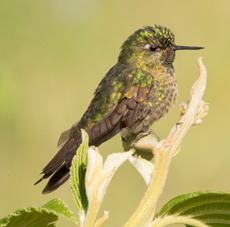
.jpg)
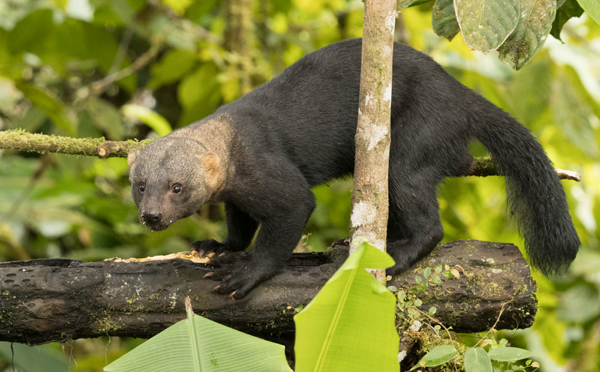
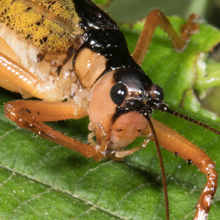
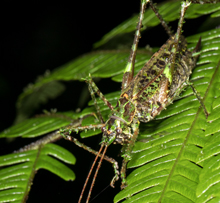
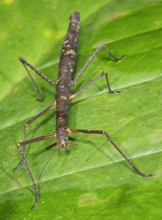
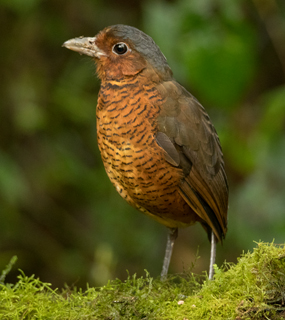
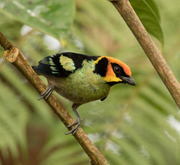
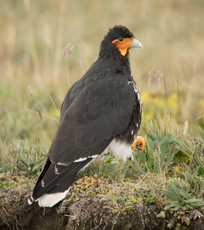
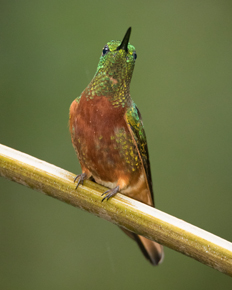 My Objective
My Objective
You should return with the best photographs of Ecuador's hummingbirds and wildlife possible in the time frame we have available. This doesn't come easily; it requires early starts, patience, and a degree of luck. We'll be supplying the flash equipment so you can expect gear that works and that is suited for the job at hand for photographing the hummingbirds.
What's Included
The photo tour for our Hummingbirds and Wildlife of Ecuador Photo Tour (six participants) is $7,295 from Quito, Ecuador, and includes all accommodations (double occupancy) as specified above, all meals as specified except day one, entrance fees, and ground transportation in our spacious, air-conditioned tour bus. Also included, professional bilingual photo/nature/culture guide, photo guide assistance with workshops and informal learning, assistance with caption and identification information, taxes for all services included and listed. A single rooming supplement is available at an additional cost.
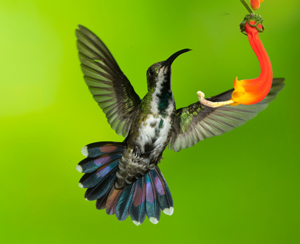 The tour price includes all meals, a welcome and farewell drink, and the driver/guide's tip. There will be five electronic flash setups (weather permitting), and participants will be rotated in a fair and equal basis through these setups.
The tour price includes all meals, a welcome and farewell drink, and the driver/guide's tip. There will be five electronic flash setups (weather permitting), and participants will be rotated in a fair and equal basis through these setups.
Gratuities for hotel or lodge staff, airport transfers, and laundry fees or lodging that takes place before or after the photo tour and those meals are not included. Also not included is Airfare to Ecuador, any Airport departure tax, alchoholic drinks (excepting our welcome and farewell receptions), non-meal time snacks, non-meal time soft drinks and bottled water, and souvenirs.
We always recommend trip cancellation insurance and Emergency Medical Evacuation Insurance is required.
Amazon Extension, Sani Lodge
We'll be doing our first scouting trip to Suni Lodge, located in Yani National Park in the heart of Ecuador's portion of the vast Amazon basin. Lodging is extremely limited here so we'll have the lodge basically to ourselves. There is a tower for canopy-level bird viewing, boat trips for water-dwelling wildlife and birds, and nocturnal excursions that reveal a hidden and very diverse and exciting world. We'll be spending four full days and one half day, upon arrival, at the lodge. A highlight will be the nearby parrot clay licks where scores, and often hundreds, of parrots of several species gather to consume clay, a natural remedy for the otherwise toxic plants these birds feed upon.
Our Roles as Leaders, and Your Role
Mary and I know wildlife, and how to photograph it. I want everyone to obtain great photographs, and to enjoy himself or herself while doing so. Great photography requires patience, luck, and time, and you can trust us that everything we do as your trip leaders will have those priorities - your photos and well-being as an individual in our group -- in mind.
Don't expect me to compromise the group for you, whether that's for tardiness, forgetfulness, or otherwise. We won't. We're up front about our time, tenacity and seriousness, and we want our people to know this. If you join us, that's what you're getting into. I think some people join a group and expect it to conform to their individual demands. We won't do that. If you like to travel privately, or to 'run the show,' or to make selfish demands, we'd suggest you go alone.
Foreign travel is exciting, but it can be exhausting for some. You very well may need to sit out a hummingbird session or feeder shoot and relax one day, and if you feel this way, please do so. We press fairly hard, but we do so because we know that many in the group have high-energy reserves, limited budgets, and inexhaustible enthusiasm, and these folks want as much out of the experience as they can get. We aim to deliver that.
About Your Leaders
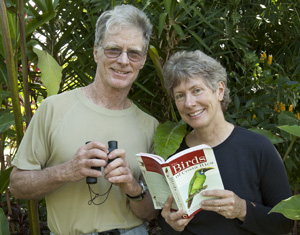 My wife Mary Ann and I strive to provide the most comfortable and thorough safari you will experience. Both Mary and I are photographers, and I'd hope you've seen our credits. These included Audubon, National Geographic, National Wildlife, Ranger Rick, Natural History, Living Bird, Birder's World, Wildlife Conservation, and most nature/wildlife calendars.
My wife Mary Ann and I strive to provide the most comfortable and thorough safari you will experience. Both Mary and I are photographers, and I'd hope you've seen our credits. These included Audubon, National Geographic, National Wildlife, Ranger Rick, Natural History, Living Bird, Birder's World, Wildlife Conservation, and most nature/wildlife calendars.
In 1994 Mary Ann won two first place awards in the prestigious BBC Wildlife Photographer of the Year competition, in Endangered Species and in Bird Behavior. In 1998 she had three highly commended images published in the BBC competition, ALL THREE from Kenya! She won first place in the Cemex/Nature's Best photo contest in the Humor Division for Professional Photographers. In 2003 she won first place in Mammal Behavior in the Agfa All Africa photo competition with a dust bathing bull elephant from Samburu. Mary has written a number of children's books, including Leopards, Grizzly Bears, Woodpeckers, Flying Squirrels, Sunflowers, Cobras, Jupiter, Boas, Garter Snakes, Pythons, Rattlesnakes, Ducks, Chickens, Horses, and Cows, and a coffee table book, Out of the Past, Amish Tradition and Faith.
I've written several how-to wildlife photography books -- A Practical Guide to Photographing American Wildlife, The Wildlife Photographer's Field Manual, The Complete Guide to Wildlife Photography, Designing Wildlife Photographs, Photographing on Safari, A Field Guide to Photographing in East Africa, and The New Complete Guide to Wildlife Photography. In 1999 Todtri published African Wildlife, and in 1999 we produced our first instructional video, A Video Guide to Photographing on Safari with Joe and Mary Ann McDonald. The video has received rave reviews, and it is the definitive guide for preparing yourself for a safari. I've won several times for highly commended images in both the Cemex/Nature's Best and the Agfa all Africa photo competitions. In 2003 I won 2nd place in the World in Our Hands category in the BBC competition with an image from Africa. In 2013 I won first place in the Mammal Behavior category, of jaguars fighting, in this competition.
Mary and I were featured in the book, the World's Best Wildlife Photographers, and we write regularly appearing columns in Nature Photographer magazine and in several web magazines. Our latest book, Creatures of the Night, deals with Nocturnal Wildlife, from Bats to Bugs, Reptiles to Mammals, and photographing these subjects. It is available directly through our office.
Contact our office at info@hoothollow.com.
The ULTIMATE Hummingbirds Trip,
and the Birds
and
Wildlife of Ecuador
Photo Tour
Dates: April 30-May 13, 2024
Price: $ 7,295


.jpg)
Optional Extension to the Amazon
May 13-18, 2024
Price: $4,595
Sani Lodge
We'll be offering a six-day extension (5 nights at the lodge) for photographing and observing the wildlife of the Amazon. There's a tower for canopy-level viewing, night walks for nocturnal wildlife, and boating trips for water birds and wildlife. There is also a nearby Parrot clay lick where scores, if not hundreds, of various parrot species visit daily. Click on the link above for more details, also available at the end of this brochure.
Check out the videos:
Hummingbirds and Wildlife of Ecuador Photo Tour
Hummingbird Video Portfolio
We've added several new shooting locations for this tour,
for more hummingbirds, birds, and wildlife!
We'll be visiting 9 different locations (many are day trips from our base) for the greatest variety of hummingbirds and other species.


Hummingbirds are the primary 'focus' of this trip and
Ecuador has an incredible variety!
You will be using our High Speed Flash for the Hummingbird set-ups
as you photograph Hummers and learn how to use high speed flash!


Weather permitting, you will also have the opportunity to photograph
flying bats with our high speed flash setups.
Limited to 5 Participants
Everyone rotates through all
of our high-speed flash sets - no down time!


Sword-billed Hummingbird - one of the most unique of all Hummers
and something you have to see to really believe! At our new, added location, you will
photograph the world's largest hummingbird, the Giant, and other species.
Incredible Hummingbird Photography using our High Speed Flash set-ups characterize this exciting tour to one of the
most accessible and rewarding wildlife destinations for Hummingbirds and other birds and wildlife in the cloud forests and upper Amazon Basin of Ecuador!




Although our primary subject will be Hummingbirds, we'll be shooting a variety of other bird species, landscapes, amphibians, and mammals at several different locations. At several of our hummingbird locations participants will be using our Flash systems to ensure razor-sharp, exciting, dynamic photographs, requiring you to do nothing more than tweak an exposure if necessary and focus!
We will have Four high-speed Flash Set-ups at our major hummingbird shooting location, meaning that when we are shooting hummingbirds four people will have their own set while one person has time to download and charge batteries. We rotate everyone through all of the hummingbird sets, ensuring that you'll have the greatest chance of catching all the action -- no matter which feeder is most active.
No other tour offers this type of accessibility and opportunity.
Ecuador's Hummingbirds are incredibly diverse, and you're likely to photograph well over twenty species, including the spectacular Swordbill and the charming Booted Racquet-tail, almost everyone's favorite. On our 2016 tour we photographed over 30 different species of hummingbird - check our trip report! For our 2018 tour we saw and photographed as many as 40 species! Read the Trip Report 2018. In 2022 we had nearly 50 species!

Spectacled Bear - The only bear found in South America and the second rarest bear in the world. Our group photographed this bear on our 2016 tour. Read about that tour to have a great idea of what our tours are like and what you too can hope to photograph!
We'll be basing our stay at several very diverse locations, where we'll be doing most of our shooting and also that we will be using as a base as we do side-trips for particular birds or mammals.
Trip Highlights
 Located on the Equator, Ecuador is a beautiful, stable, and diverse country, with an incredible variety of Hummingbirds and other bird species. We'll be based at several lodges, including one in Ecuador's cloud forest, one at the base of the Andies in transitional forest where alpine species like Torrent Ducks and Dippers live adjacent to the forest and subtropical Hummingbirds, and one in the upper reaches of the Amazon Basin, where true tropical forest birds and mammals and frogs and treefrogs are found.
Located on the Equator, Ecuador is a beautiful, stable, and diverse country, with an incredible variety of Hummingbirds and other bird species. We'll be based at several lodges, including one in Ecuador's cloud forest, one at the base of the Andies in transitional forest where alpine species like Torrent Ducks and Dippers live adjacent to the forest and subtropical Hummingbirds, and one in the upper reaches of the Amazon Basin, where true tropical forest birds and mammals and frogs and treefrogs are found.
Additionally, in the highlands where, weather permitting, we'll spend a wonderful morning photographing snow-capped volcanoes at our highest elevation of the trip, we may also encounter South America's only bear, the Spectacled Bear.




Although mammal activity is rather limited, except at our third shooting location, we have photographed Three-toed Sloths, Olinquita, and Opossums at our various locations. For anyone interested, and who brings the correct equipment, you would have the opportunity for remote, unmanned photography of the nocturnal mammals.
At our last destination, in the upper reaches of the Amazon basin, we may have the opportunity to photograph a few primates (the Napo Tamarin is almost a definite), in addition to the tropical birds visiting the feeders.



We'll also be shooting birds as they visit traditional feeders, where we won't worry whether or not a feeder shows in the image. Sometimes simple cropping can eliminate a feeder, but I'll be showing you how to make unique, dynamic and original images as well, via Photoshop and Flower EXTRACTIONS that I will provide.
We'll also use sugar water-baited flowers, so you'll have a variety of options with your photography.


That's the exciting aspect of this tour, as we'll be doing a mini-Photoshop workshop on how you can composite images to maximize our shooting. While all of us would love to be able to shoot every hummingbird at a natural flower, time, cooperation, and opportunity precludes that wish every time. Via Photoshop, however, we can maximize our shooting opportunities!
I have an ebook that details how to do this which you'll receive via a free link to our ejunkie book selling site and we'll have an abridged version that you'll receive during the tour. With this information, anyone using Photoshop can easily add a flower!


Some of the following images are composites, and some are straight shots.
Can you tell the difference?








Our Various Locations
We will be visiting several great and quite diverse locations, without the inconvenience and the down-time that would be involved in changing lodges frequently. Instead, we'll be based at three locations, all terrific locations for bird and wildlife photography, and within easy driving distance of several other locations. The result -- a tremendous amount of diversity, including scenics, birds, frogs and treefrogs, and mammals. On the final day of the tour we'll head back to Quito and spend the night in a hotel near to the airport. The following morning we'll leave early for a daytrip into the higher elevations of the Antisana area. We'll be looking for a few new species of hummers as well as some other bird species that frequent this high altitude.
Our first Lodge


Three of our five set-ups are shown above. You'll be sitting comfortably at whatever distance you need for the lens you are using, although a 100-400, 70-300, or similar is perfect for these set-ups. Each set-up has four flashes, providing a variety of different lighting, and we have a variety of backgrounds as well.


Although it is usually too uncomfortable to photograph in a heavy rain, we do shoot in drizzles -- which often do not last very long. The birds themselves are fearless!
We'll have four nights at one of the premier Hummingbird photography locations in the world. I'm not exaggerating when I say that hummers at our lodge's feeders are as thick as bees -- it is an incredible sight to see a half dozen species all swarming around a feeder.

Of course, swarms of Hummingbirds are difficult to photograph, and we'll be setting up our special feeders and flowers nearby, siphoning off species that will make our photography easier, and more effective.
This Lodge will be our base for day-trips to three or four other locations, and you'll have plenty of time to photograph Hummingbirds from the comfort of the porches of the Lodge.





 Some of our other locationso!
Some of our other locationso!
We'll do day trips to several other locations where we'll photograph Hummingbirds, Aracaris, Mot-Mots, and a variety of songbirds. We'll be in Three-toed Sloth country, and if we're lucky we'll get a good view, and great shots, of this interesting and often cryptic species.

.jpg) The Lek
The Lek
One of the iconic species of the cloud forest is the spectacular Cock-of-the-Rock, a large pigeon-sized bird feathered in a golden orange plumage and topped by a sweeping crest that creates a distinctive and unique shape. We'll also be vsiting a ranch where a special viewing area/hide can provide spectacular shots.
Left, Photo by Judy Johnson
Guango Lodge
Guango is famous for the incredible Sword-bill Hummingbird, who sports a beak longer than its body. There are a variety of hummingbirds here, including several species, like the Chestnut-breasted Coronet, Collared Inca, Tourmaline Brilliant, and of course the Swordbill.The mountain stream that borders the property has White-capped Dippers, Torrent Ducks, and several forest birds. We'll have flashes set-up but some of the most productive shooting here has been with on-camera flash at the numerous feeders and perching areas. We'll be discussing how to balance flash and ambient light exposures for the most natural look.



Papallacta Pass
We'll be in Spectacled Bear country, South America's only bear, and if the weather is clear, we'll be treated to spectacular views of snow-capped dormant volcanoes. Weather permitting, we'll spend a morning in this high country, looking for bears and endemic birds, and photographing the volcanoes. This visit is weather dependent, as rain or fog may make photographing or sighting wildlife impossible.
Antisana National Park
 We'll be visiting the high altitudes outside Quito for Andean Condors and several new species of hummingbirds, as well as other species of birds.
We'll be visiting the high altitudes outside Quito for Andean Condors and several new species of hummingbirds, as well as other species of birds.
 Tamarin-16-5072.jpg) Upper Amazon basin
Upper Amazon basin
Our last location will be a beautiful lodge in the upper Amazon Basin. Treefrogs and frogs and other nocturnal subjects, including a variety of insects, are one of the highlights here, although there are a number of new Hummingbird species. We'll be photographing these species in natural light or with on-camera flash, which will also make our other bird and mammal photography more productive as well. Tamarins and the potential for some other jungle mammals, will be other subjects we'll be seeking.
As we visit several different locations, the variety of subjects seems endless...


.jpg)







 My Objective
My Objective
You should return with the best photographs of Ecuador's hummingbirds and wildlife possible in the time frame we have available. This doesn't come easily; it requires early starts, patience, and a degree of luck. We'll be supplying the flash equipment so you can expect gear that works and that is suited for the job at hand for photographing the hummingbirds.
What's Included
The photo tour for our Hummingbirds and Wildlife of Ecuador Photo Tour (six participants) is $7,295 from Quito, Ecuador, and includes all accommodations (double occupancy) as specified above, all meals as specified except day one, entrance fees, and ground transportation in our spacious, air-conditioned tour bus. Also included, professional bilingual photo/nature/culture guide, photo guide assistance with workshops and informal learning, assistance with caption and identification information, taxes for all services included and listed. A single rooming supplement is available at an additional cost.
 The tour price includes all meals, a welcome and farewell drink, and the driver/guide's tip. There will be five electronic flash setups (weather permitting), and participants will be rotated in a fair and equal basis through these setups.
The tour price includes all meals, a welcome and farewell drink, and the driver/guide's tip. There will be five electronic flash setups (weather permitting), and participants will be rotated in a fair and equal basis through these setups.
Gratuities for hotel or lodge staff, airport transfers, and laundry fees or lodging that takes place before or after the photo tour and those meals are not included. Also not included is Airfare to Ecuador, any Airport departure tax, alchoholic drinks (excepting our welcome and farewell receptions), non-meal time snacks, non-meal time soft drinks and bottled water, and souvenirs.
We always recommend trip cancellation insurance and Emergency Medical Evacuation Insurance is required.
Amazon Extension, Sani Lodge
We'll be doing our first scouting trip to Suni Lodge, located in Yani National Park in the heart of Ecuador's portion of the vast Amazon basin. Lodging is extremely limited here so we'll have the lodge basically to ourselves. There is a tower for canopy-level bird viewing, boat trips for water-dwelling wildlife and birds, and nocturnal excursions that reveal a hidden and very diverse and exciting world. We'll be spending four full days and one half day, upon arrival, at the lodge. A highlight will be the nearby parrot clay licks where scores, and often hundreds, of parrots of several species gather to consume clay, a natural remedy for the otherwise toxic plants these birds feed upon.
Our Roles as Leaders, and Your Role
Mary and I know wildlife, and how to photograph it. I want everyone to obtain great photographs, and to enjoy himself or herself while doing so. Great photography requires patience, luck, and time, and you can trust us that everything we do as your trip leaders will have those priorities - your photos and well-being as an individual in our group -- in mind.
Don't expect me to compromise the group for you, whether that's for tardiness, forgetfulness, or otherwise. We won't. We're up front about our time, tenacity and seriousness, and we want our people to know this. If you join us, that's what you're getting into. I think some people join a group and expect it to conform to their individual demands. We won't do that. If you like to travel privately, or to 'run the show,' or to make selfish demands, we'd suggest you go alone.
Foreign travel is exciting, but it can be exhausting for some. You very well may need to sit out a hummingbird session or feeder shoot and relax one day, and if you feel this way, please do so. We press fairly hard, but we do so because we know that many in the group have high-energy reserves, limited budgets, and inexhaustible enthusiasm, and these folks want as much out of the experience as they can get. We aim to deliver that.
About Your Leaders
 My wife Mary Ann and I strive to provide the most comfortable and thorough safari you will experience. Both Mary and I are photographers, and I'd hope you've seen our credits. These included Audubon, National Geographic, National Wildlife, Ranger Rick, Natural History, Living Bird, Birder's World, Wildlife Conservation, and most nature/wildlife calendars.
My wife Mary Ann and I strive to provide the most comfortable and thorough safari you will experience. Both Mary and I are photographers, and I'd hope you've seen our credits. These included Audubon, National Geographic, National Wildlife, Ranger Rick, Natural History, Living Bird, Birder's World, Wildlife Conservation, and most nature/wildlife calendars.
In 1994 Mary Ann won two first place awards in the prestigious BBC Wildlife Photographer of the Year competition, in Endangered Species and in Bird Behavior. In 1998 she had three highly commended images published in the BBC competition, ALL THREE from Kenya! She won first place in the Cemex/Nature's Best photo contest in the Humor Division for Professional Photographers. In 2003 she won first place in Mammal Behavior in the Agfa All Africa photo competition with a dust bathing bull elephant from Samburu. Mary has written a number of children's books, including Leopards, Grizzly Bears, Woodpeckers, Flying Squirrels, Sunflowers, Cobras, Jupiter, Boas, Garter Snakes, Pythons, Rattlesnakes, Ducks, Chickens, Horses, and Cows, and a coffee table book, Out of the Past, Amish Tradition and Faith.
I've written several how-to wildlife photography books -- A Practical Guide to Photographing American Wildlife, The Wildlife Photographer's Field Manual, The Complete Guide to Wildlife Photography, Designing Wildlife Photographs, Photographing on Safari, A Field Guide to Photographing in East Africa, and The New Complete Guide to Wildlife Photography. In 1999 Todtri published African Wildlife, and in 1999 we produced our first instructional video, A Video Guide to Photographing on Safari with Joe and Mary Ann McDonald. The video has received rave reviews, and it is the definitive guide for preparing yourself for a safari. I've won several times for highly commended images in both the Cemex/Nature's Best and the Agfa all Africa photo competitions. In 2003 I won 2nd place in the World in Our Hands category in the BBC competition with an image from Africa. In 2013 I won first place in the Mammal Behavior category, of jaguars fighting, in this competition.
Mary and I were featured in the book, the World's Best Wildlife Photographers, and we write regularly appearing columns in Nature Photographer magazine and in several web magazines. Our latest book, Creatures of the Night, deals with Nocturnal Wildlife, from Bats to Bugs, Reptiles to Mammals, and photographing these subjects. It is available directly through our office.
Contact our office at info@hoothollow.com.
The ULTIMATE Hummingbirds Trip,
and the Birds
and
Wildlife of Ecuador
Photo Tour
Dates: April 30-May 13, 2024
Price: $ 7,295


.jpg)
Optional Extension to the Amazon
May 13-18, 2024
Price: $4,595
Sani Lodge
We'll be offering a six-day extension (5 nights at the lodge) for photographing and observing the wildlife of the Amazon. There's a tower for canopy-level viewing, night walks for nocturnal wildlife, and boating trips for water birds and wildlife. There is also a nearby Parrot clay lick where scores, if not hundreds, of various parrot species visit daily. Click on the link above for more details, also available at the end of this brochure.
Check out the videos:
Hummingbirds and Wildlife of Ecuador Photo Tour
Hummingbird Video Portfolio
We've added several new shooting locations for this tour,
for more hummingbirds, birds, and wildlife!
We'll be visiting 9 different locations (many are day trips from our base) for the greatest variety of hummingbirds and other species.


Hummingbirds are the primary 'focus' of this trip and
Ecuador has an incredible variety!
You will be using our High Speed Flash for the Hummingbird set-ups
as you photograph Hummers and learn how to use high speed flash!


Weather permitting, you will also have the opportunity to photograph
flying bats with our high speed flash setups.
Limited to 5 Participants
Everyone rotates through all
of our high-speed flash sets - no down time!


Sword-billed Hummingbird - one of the most unique of all Hummers
and something you have to see to really believe! At our new, added location, you will
photograph the world's largest hummingbird, the Giant, and other species.
Incredible Hummingbird Photography using our High Speed Flash set-ups characterize this exciting tour to one of the
most accessible and rewarding wildlife destinations for Hummingbirds and other birds and wildlife in the cloud forests and upper Amazon Basin of Ecuador!




Although our primary subject will be Hummingbirds, we'll be shooting a variety of other bird species, landscapes, amphibians, and mammals at several different locations. At several of our hummingbird locations participants will be using our Flash systems to ensure razor-sharp, exciting, dynamic photographs, requiring you to do nothing more than tweak an exposure if necessary and focus!
We will have Four high-speed Flash Set-ups at our major hummingbird shooting location, meaning that when we are shooting hummingbirds four people will have their own set while one person has time to download and charge batteries. We rotate everyone through all of the hummingbird sets, ensuring that you'll have the greatest chance of catching all the action -- no matter which feeder is most active.
No other tour offers this type of accessibility and opportunity.
Ecuador's Hummingbirds are incredibly diverse, and you're likely to photograph well over twenty species, including the spectacular Swordbill and the charming Booted Racquet-tail, almost everyone's favorite. On our 2016 tour we photographed over 30 different species of hummingbird - check our trip report! For our 2018 tour we saw and photographed as many as 40 species! Read the Trip Report 2018. In 2022 we had nearly 50 species!

Spectacled Bear - The only bear found in South America and the second rarest bear in the world. Our group photographed this bear on our 2016 tour. Read about that tour to have a great idea of what our tours are like and what you too can hope to photograph!
We'll be basing our stay at several very diverse locations, where we'll be doing most of our shooting and also that we will be using as a base as we do side-trips for particular birds or mammals.
Trip Highlights
 Located on the Equator, Ecuador is a beautiful, stable, and diverse country, with an incredible variety of Hummingbirds and other bird species. We'll be based at several lodges, including one in Ecuador's cloud forest, one at the base of the Andies in transitional forest where alpine species like Torrent Ducks and Dippers live adjacent to the forest and subtropical Hummingbirds, and one in the upper reaches of the Amazon Basin, where true tropical forest birds and mammals and frogs and treefrogs are found.
Located on the Equator, Ecuador is a beautiful, stable, and diverse country, with an incredible variety of Hummingbirds and other bird species. We'll be based at several lodges, including one in Ecuador's cloud forest, one at the base of the Andies in transitional forest where alpine species like Torrent Ducks and Dippers live adjacent to the forest and subtropical Hummingbirds, and one in the upper reaches of the Amazon Basin, where true tropical forest birds and mammals and frogs and treefrogs are found.
Additionally, in the highlands where, weather permitting, we'll spend a wonderful morning photographing snow-capped volcanoes at our highest elevation of the trip, we may also encounter South America's only bear, the Spectacled Bear.




Although mammal activity is rather limited, except at our third shooting location, we have photographed Three-toed Sloths, Olinquita, and Opossums at our various locations. For anyone interested, and who brings the correct equipment, you would have the opportunity for remote, unmanned photography of the nocturnal mammals.
At our last destination, in the upper reaches of the Amazon basin, we may have the opportunity to photograph a few primates (the Napo Tamarin is almost a definite), in addition to the tropical birds visiting the feeders.



We'll also be shooting birds as they visit traditional feeders, where we won't worry whether or not a feeder shows in the image. Sometimes simple cropping can eliminate a feeder, but I'll be showing you how to make unique, dynamic and original images as well, via Photoshop and Flower EXTRACTIONS that I will provide.
We'll also use sugar water-baited flowers, so you'll have a variety of options with your photography.


That's the exciting aspect of this tour, as we'll be doing a mini-Photoshop workshop on how you can composite images to maximize our shooting. While all of us would love to be able to shoot every hummingbird at a natural flower, time, cooperation, and opportunity precludes that wish every time. Via Photoshop, however, we can maximize our shooting opportunities!
I have an ebook that details how to do this which you'll receive via a free link to our ejunkie book selling site and we'll have an abridged version that you'll receive during the tour. With this information, anyone using Photoshop can easily add a flower!


Some of the following images are composites, and some are straight shots.
Can you tell the difference?








Our Various Locations
We will be visiting several great and quite diverse locations, without the inconvenience and the down-time that would be involved in changing lodges frequently. Instead, we'll be based at three locations, all terrific locations for bird and wildlife photography, and within easy driving distance of several other locations. The result -- a tremendous amount of diversity, including scenics, birds, frogs and treefrogs, and mammals. On the final day of the tour we'll head back to Quito and spend the night in a hotel near to the airport. The following morning we'll leave early for a daytrip into the higher elevations of the Antisana area. We'll be looking for a few new species of hummers as well as some other bird species that frequent this high altitude.
Our first Lodge


Three of our five set-ups are shown above. You'll be sitting comfortably at whatever distance you need for the lens you are using, although a 100-400, 70-300, or similar is perfect for these set-ups. Each set-up has four flashes, providing a variety of different lighting, and we have a variety of backgrounds as well.


Although it is usually too uncomfortable to photograph in a heavy rain, we do shoot in drizzles -- which often do not last very long. The birds themselves are fearless!
We'll have four nights at one of the premier Hummingbird photography locations in the world. I'm not exaggerating when I say that hummers at our lodge's feeders are as thick as bees -- it is an incredible sight to see a half dozen species all swarming around a feeder.

Of course, swarms of Hummingbirds are difficult to photograph, and we'll be setting up our special feeders and flowers nearby, siphoning off species that will make our photography easier, and more effective.
This Lodge will be our base for day-trips to three or four other locations, and you'll have plenty of time to photograph Hummingbirds from the comfort of the porches of the Lodge.





 Some of our other locationso!
Some of our other locationso!
We'll do day trips to several other locations where we'll photograph Hummingbirds, Aracaris, Mot-Mots, and a variety of songbirds. We'll be in Three-toed Sloth country, and if we're lucky we'll get a good view, and great shots, of this interesting and often cryptic species.

.jpg) The Lek
The Lek
One of the iconic species of the cloud forest is the spectacular Cock-of-the-Rock, a large pigeon-sized bird feathered in a golden orange plumage and topped by a sweeping crest that creates a distinctive and unique shape. We'll also be vsiting a ranch where a special viewing area/hide can provide spectacular shots.
Left, Photo by Judy Johnson
Guango Lodge
Guango is famous for the incredible Sword-bill Hummingbird, who sports a beak longer than its body. There are a variety of hummingbirds here, including several species, like the Chestnut-breasted Coronet, Collared Inca, Tourmaline Brilliant, and of course the Swordbill.The mountain stream that borders the property has White-capped Dippers, Torrent Ducks, and several forest birds. We'll have flashes set-up but some of the most productive shooting here has been with on-camera flash at the numerous feeders and perching areas. We'll be discussing how to balance flash and ambient light exposures for the most natural look.



Papallacta Pass
We'll be in Spectacled Bear country, South America's only bear, and if the weather is clear, we'll be treated to spectacular views of snow-capped dormant volcanoes. Weather permitting, we'll spend a morning in this high country, looking for bears and endemic birds, and photographing the volcanoes. This visit is weather dependent, as rain or fog may make photographing or sighting wildlife impossible.
Antisana National Park
 We'll be visiting the high altitudes outside Quito for Andean Condors and several new species of hummingbirds, as well as other species of birds.
We'll be visiting the high altitudes outside Quito for Andean Condors and several new species of hummingbirds, as well as other species of birds.
 Tamarin-16-5072.jpg) Upper Amazon basin
Upper Amazon basin
Our last location will be a beautiful lodge in the upper Amazon Basin. Treefrogs and frogs and other nocturnal subjects, including a variety of insects, are one of the highlights here, although there are a number of new Hummingbird species. We'll be photographing these species in natural light or with on-camera flash, which will also make our other bird and mammal photography more productive as well. Tamarins and the potential for some other jungle mammals, will be other subjects we'll be seeking.
As we visit several different locations, the variety of subjects seems endless...


.jpg)







 My Objective
My Objective
You should return with the best photographs of Ecuador's hummingbirds and wildlife possible in the time frame we have available. This doesn't come easily; it requires early starts, patience, and a degree of luck. We'll be supplying the flash equipment so you can expect gear that works and that is suited for the job at hand for photographing the hummingbirds.
What's Included
The photo tour for our Hummingbirds and Wildlife of Ecuador Photo Tour (six participants) is $7,295 from Quito, Ecuador, and includes all accommodations (double occupancy) as specified above, all meals as specified except day one, entrance fees, and ground transportation in our spacious, air-conditioned tour bus. Also included, professional bilingual photo/nature/culture guide, photo guide assistance with workshops and informal learning, assistance with caption and identification information, taxes for all services included and listed. A single rooming supplement is available at an additional cost.
 The tour price includes all meals, a welcome and farewell drink, and the driver/guide's tip. There will be five electronic flash setups (weather permitting), and participants will be rotated in a fair and equal basis through these setups.
The tour price includes all meals, a welcome and farewell drink, and the driver/guide's tip. There will be five electronic flash setups (weather permitting), and participants will be rotated in a fair and equal basis through these setups.
Gratuities for hotel or lodge staff, airport transfers, and laundry fees or lodging that takes place before or after the photo tour and those meals are not included. Also not included is Airfare to Ecuador, any Airport departure tax, alchoholic drinks (excepting our welcome and farewell receptions), non-meal time snacks, non-meal time soft drinks and bottled water, and souvenirs.
We always recommend trip cancellation insurance and Emergency Medical Evacuation Insurance is required.
Amazon Extension, Sani Lodge
We'll be doing our first scouting trip to Suni Lodge, located in Yani National Park in the heart of Ecuador's portion of the vast Amazon basin. Lodging is extremely limited here so we'll have the lodge basically to ourselves. There is a tower for canopy-level bird viewing, boat trips for water-dwelling wildlife and birds, and nocturnal excursions that reveal a hidden and very diverse and exciting world. We'll be spending four full days and one half day, upon arrival, at the lodge. A highlight will be the nearby parrot clay licks where scores, and often hundreds, of parrots of several species gather to consume clay, a natural remedy for the otherwise toxic plants these birds feed upon.
Our Roles as Leaders, and Your Role
Mary and I know wildlife, and how to photograph it. I want everyone to obtain great photographs, and to enjoy himself or herself while doing so. Great photography requires patience, luck, and time, and you can trust us that everything we do as your trip leaders will have those priorities - your photos and well-being as an individual in our group -- in mind.
Don't expect me to compromise the group for you, whether that's for tardiness, forgetfulness, or otherwise. We won't. We're up front about our time, tenacity and seriousness, and we want our people to know this. If you join us, that's what you're getting into. I think some people join a group and expect it to conform to their individual demands. We won't do that. If you like to travel privately, or to 'run the show,' or to make selfish demands, we'd suggest you go alone.
Foreign travel is exciting, but it can be exhausting for some. You very well may need to sit out a hummingbird session or feeder shoot and relax one day, and if you feel this way, please do so. We press fairly hard, but we do so because we know that many in the group have high-energy reserves, limited budgets, and inexhaustible enthusiasm, and these folks want as much out of the experience as they can get. We aim to deliver that.
About Your Leaders
 My wife Mary Ann and I strive to provide the most comfortable and thorough safari you will experience. Both Mary and I are photographers, and I'd hope you've seen our credits. These included Audubon, National Geographic, National Wildlife, Ranger Rick, Natural History, Living Bird, Birder's World, Wildlife Conservation, and most nature/wildlife calendars.
My wife Mary Ann and I strive to provide the most comfortable and thorough safari you will experience. Both Mary and I are photographers, and I'd hope you've seen our credits. These included Audubon, National Geographic, National Wildlife, Ranger Rick, Natural History, Living Bird, Birder's World, Wildlife Conservation, and most nature/wildlife calendars.
In 1994 Mary Ann won two first place awards in the prestigious BBC Wildlife Photographer of the Year competition, in Endangered Species and in Bird Behavior. In 1998 she had three highly commended images published in the BBC competition, ALL THREE from Kenya! She won first place in the Cemex/Nature's Best photo contest in the Humor Division for Professional Photographers. In 2003 she won first place in Mammal Behavior in the Agfa All Africa photo competition with a dust bathing bull elephant from Samburu. Mary has written a number of children's books, including Leopards, Grizzly Bears, Woodpeckers, Flying Squirrels, Sunflowers, Cobras, Jupiter, Boas, Garter Snakes, Pythons, Rattlesnakes, Ducks, Chickens, Horses, and Cows, and a coffee table book, Out of the Past, Amish Tradition and Faith.
I've written several how-to wildlife photography books -- A Practical Guide to Photographing American Wildlife, The Wildlife Photographer's Field Manual, The Complete Guide to Wildlife Photography, Designing Wildlife Photographs, Photographing on Safari, A Field Guide to Photographing in East Africa, and The New Complete Guide to Wildlife Photography. In 1999 Todtri published African Wildlife, and in 1999 we produced our first instructional video, A Video Guide to Photographing on Safari with Joe and Mary Ann McDonald. The video has received rave reviews, and it is the definitive guide for preparing yourself for a safari. I've won several times for highly commended images in both the Cemex/Nature's Best and the Agfa all Africa photo competitions. In 2003 I won 2nd place in the World in Our Hands category in the BBC competition with an image from Africa. In 2013 I won first place in the Mammal Behavior category, of jaguars fighting, in this competition.
Mary and I were featured in the book, the World's Best Wildlife Photographers, and we write regularly appearing columns in Nature Photographer magazine and in several web magazines. Our latest book, Creatures of the Night, deals with Nocturnal Wildlife, from Bats to Bugs, Reptiles to Mammals, and photographing these subjects. It is available directly through our office.
Contact our office at info@hoothollow.com.
The ULTIMATE Hummingbirds Trip,
and the Birds
and
Wildlife of Ecuador
Photo Tour
Dates: April 30-May 13, 2024
Price: $ 7,295


.jpg)
Optional Extension to the Amazon
May 13-18, 2024
Price: $4,595
Sani Lodge
We'll be offering a six-day extension (5 nights at the lodge) for photographing and observing the wildlife of the Amazon. There's a tower for canopy-level viewing, night walks for nocturnal wildlife, and boating trips for water birds and wildlife. There is also a nearby Parrot clay lick where scores, if not hundreds, of various parrot species visit daily. Click on the link above for more details, also available at the end of this brochure.
Check out the videos:
Hummingbirds and Wildlife of Ecuador Photo Tour
Hummingbird Video Portfolio
We've added several new shooting locations for this tour,
for more hummingbirds, birds, and wildlife!
We'll be visiting 9 different locations (many are day trips from our base) for the greatest variety of hummingbirds and other species.


Hummingbirds are the primary 'focus' of this trip and
Ecuador has an incredible variety!
You will be using our High Speed Flash for the Hummingbird set-ups
as you photograph Hummers and learn how to use high speed flash!


Weather permitting, you will also have the opportunity to photograph
flying bats with our high speed flash setups.
Limited to 5 Participants
Everyone rotates through all
of our high-speed flash sets - no down time!


Sword-billed Hummingbird - one of the most unique of all Hummers
and something you have to see to really believe! At our new, added location, you will
photograph the world's largest hummingbird, the Giant, and other species.
Incredible Hummingbird Photography using our High Speed Flash set-ups characterize this exciting tour to one of the
most accessible and rewarding wildlife destinations for Hummingbirds and other birds and wildlife in the cloud forests and upper Amazon Basin of Ecuador!




Although our primary subject will be Hummingbirds, we'll be shooting a variety of other bird species, landscapes, amphibians, and mammals at several different locations. At several of our hummingbird locations participants will be using our Flash systems to ensure razor-sharp, exciting, dynamic photographs, requiring you to do nothing more than tweak an exposure if necessary and focus!
| We will have Four high-speed Flash Set-ups at our major hummingbird shooting location, meaning that when we are shooting hummingbirds four people will have their own set while one person has time to download and charge batteries. We rotate everyone through all of the hummingbird sets, ensuring that you'll have the greatest chance of catching all the action -- no matter which feeder is most active. No other tour offers this type of accessibility and opportunity. |
Ecuador's Hummingbirds are incredibly diverse, and you're likely to photograph well over twenty species, including the spectacular Swordbill and the charming Booted Racquet-tail, almost everyone's favorite. On our 2016 tour we photographed over 30 different species of hummingbird - check our trip report! For our 2018 tour we saw and photographed as many as 40 species! Read the Trip Report 2018. In 2022 we had nearly 50 species!

Spectacled Bear - The only bear found in South America and the second rarest bear in the world. Our group photographed this bear on our 2016 tour. Read about that tour to have a great idea of what our tours are like and what you too can hope to photograph!
We'll be basing our stay at several very diverse locations, where we'll be doing most of our shooting and also that we will be using as a base as we do side-trips for particular birds or mammals.
Trip Highlights
 Located on the Equator, Ecuador is a beautiful, stable, and diverse country, with an incredible variety of Hummingbirds and other bird species. We'll be based at several lodges, including one in Ecuador's cloud forest, one at the base of the Andies in transitional forest where alpine species like Torrent Ducks and Dippers live adjacent to the forest and subtropical Hummingbirds, and one in the upper reaches of the Amazon Basin, where true tropical forest birds and mammals and frogs and treefrogs are found.
Located on the Equator, Ecuador is a beautiful, stable, and diverse country, with an incredible variety of Hummingbirds and other bird species. We'll be based at several lodges, including one in Ecuador's cloud forest, one at the base of the Andies in transitional forest where alpine species like Torrent Ducks and Dippers live adjacent to the forest and subtropical Hummingbirds, and one in the upper reaches of the Amazon Basin, where true tropical forest birds and mammals and frogs and treefrogs are found.
Additionally, in the highlands where, weather permitting, we'll spend a wonderful morning photographing snow-capped volcanoes at our highest elevation of the trip, we may also encounter South America's only bear, the Spectacled Bear.




Although mammal activity is rather limited, except at our third shooting location, we have photographed Three-toed Sloths, Olinquita, and Opossums at our various locations. For anyone interested, and who brings the correct equipment, you would have the opportunity for remote, unmanned photography of the nocturnal mammals.
At our last destination, in the upper reaches of the Amazon basin, we may have the opportunity to photograph a few primates (the Napo Tamarin is almost a definite), in addition to the tropical birds visiting the feeders.



We'll also be shooting birds as they visit traditional feeders, where we won't worry whether or not a feeder shows in the image. Sometimes simple cropping can eliminate a feeder, but I'll be showing you how to make unique, dynamic and original images as well, via Photoshop and Flower EXTRACTIONS that I will provide.
We'll also use sugar water-baited flowers, so you'll have a variety of options with your photography.


That's the exciting aspect of this tour, as we'll be doing a mini-Photoshop workshop on how you can composite images to maximize our shooting. While all of us would love to be able to shoot every hummingbird at a natural flower, time, cooperation, and opportunity precludes that wish every time. Via Photoshop, however, we can maximize our shooting opportunities!
I have an ebook that details how to do this which you'll receive via a free link to our ejunkie book selling site and we'll have an abridged version that you'll receive during the tour. With this information, anyone using Photoshop can easily add a flower!


Some of the following images are composites, and some are straight shots.
Can you tell the difference?








Our Various Locations
We will be visiting several great and quite diverse locations, without the inconvenience and the down-time that would be involved in changing lodges frequently. Instead, we'll be based at three locations, all terrific locations for bird and wildlife photography, and within easy driving distance of several other locations. The result -- a tremendous amount of diversity, including scenics, birds, frogs and treefrogs, and mammals. On the final day of the tour we'll head back to Quito and spend the night in a hotel near to the airport. The following morning we'll leave early for a daytrip into the higher elevations of the Antisana area. We'll be looking for a few new species of hummers as well as some other bird species that frequent this high altitude.
Our first Lodge


Three of our five set-ups are shown above. You'll be sitting comfortably at whatever distance you need for the lens you are using, although a 100-400, 70-300, or similar is perfect for these set-ups. Each set-up has four flashes, providing a variety of different lighting, and we have a variety of backgrounds as well.


Although it is usually too uncomfortable to photograph in a heavy rain, we do shoot in drizzles -- which often do not last very long. The birds themselves are fearless!
We'll have four nights at one of the premier Hummingbird photography locations in the world. I'm not exaggerating when I say that hummers at our lodge's feeders are as thick as bees -- it is an incredible sight to see a half dozen species all swarming around a feeder.

Of course, swarms of Hummingbirds are difficult to photograph, and we'll be setting up our special feeders and flowers nearby, siphoning off species that will make our photography easier, and more effective.
This Lodge will be our base for day-trips to three or four other locations, and you'll have plenty of time to photograph Hummingbirds from the comfort of the porches of the Lodge.





 Some of our other locationso!
Some of our other locationso!
We'll do day trips to several other locations where we'll photograph Hummingbirds, Aracaris, Mot-Mots, and a variety of songbirds. We'll be in Three-toed Sloth country, and if we're lucky we'll get a good view, and great shots, of this interesting and often cryptic species.

.jpg) The Lek
The Lek
One of the iconic species of the cloud forest is the spectacular Cock-of-the-Rock, a large pigeon-sized bird feathered in a golden orange plumage and topped by a sweeping crest that creates a distinctive and unique shape. We'll also be vsiting a ranch where a special viewing area/hide can provide spectacular shots.
Left, Photo by Judy Johnson
Guango Lodge
Guango is famous for the incredible Sword-bill Hummingbird, who sports a beak longer than its body. There are a variety of hummingbirds here, including several species, like the Chestnut-breasted Coronet, Collared Inca, Tourmaline Brilliant, and of course the Swordbill.The mountain stream that borders the property has White-capped Dippers, Torrent Ducks, and several forest birds. We'll have flashes set-up but some of the most productive shooting here has been with on-camera flash at the numerous feeders and perching areas. We'll be discussing how to balance flash and ambient light exposures for the most natural look.



Papallacta Pass
We'll be in Spectacled Bear country, South America's only bear, and if the weather is clear, we'll be treated to spectacular views of snow-capped dormant volcanoes. Weather permitting, we'll spend a morning in this high country, looking for bears and endemic birds, and photographing the volcanoes. This visit is weather dependent, as rain or fog may make photographing or sighting wildlife impossible.
Antisana National Park
 We'll be visiting the high altitudes outside Quito for Andean Condors and several new species of hummingbirds, as well as other species of birds.
We'll be visiting the high altitudes outside Quito for Andean Condors and several new species of hummingbirds, as well as other species of birds.
 Tamarin-16-5072.jpg) Upper Amazon basin
Upper Amazon basin
Our last location will be a beautiful lodge in the upper Amazon Basin. Treefrogs and frogs and other nocturnal subjects, including a variety of insects, are one of the highlights here, although there are a number of new Hummingbird species. We'll be photographing these species in natural light or with on-camera flash, which will also make our other bird and mammal photography more productive as well. Tamarins and the potential for some other jungle mammals, will be other subjects we'll be seeking.
As we visit several different locations, the variety of subjects seems endless...


.jpg)







 My Objective
My Objective
You should return with the best photographs of Ecuador's hummingbirds and wildlife possible in the time frame we have available. This doesn't come easily; it requires early starts, patience, and a degree of luck. We'll be supplying the flash equipment so you can expect gear that works and that is suited for the job at hand for photographing the hummingbirds.
The photo tour for our Hummingbirds and Wildlife of Ecuador Photo Tour (six participants) is $7,295 from Quito, Ecuador, and includes all accommodations (double occupancy) as specified above, all meals as specified except day one, entrance fees, and ground transportation in our spacious, air-conditioned tour bus. Also included, professional bilingual photo/nature/culture guide, photo guide assistance with workshops and informal learning, assistance with caption and identification information, taxes for all services included and listed. A single rooming supplement is available at an additional cost.
 The tour price includes all meals, a welcome and farewell drink, and the driver/guide's tip. There will be five electronic flash setups (weather permitting), and participants will be rotated in a fair and equal basis through these setups.
The tour price includes all meals, a welcome and farewell drink, and the driver/guide's tip. There will be five electronic flash setups (weather permitting), and participants will be rotated in a fair and equal basis through these setups.
Gratuities for hotel or lodge staff, airport transfers, and laundry fees or lodging that takes place before or after the photo tour and those meals are not included. Also not included is Airfare to Ecuador, any Airport departure tax, alchoholic drinks (excepting our welcome and farewell receptions), non-meal time snacks, non-meal time soft drinks and bottled water, and souvenirs.
We always recommend trip cancellation insurance and Emergency Medical Evacuation Insurance is required.
Amazon Extension, Sani Lodge
We'll be doing our first scouting trip to Suni Lodge, located in Yani National Park in the heart of Ecuador's portion of the vast Amazon basin. Lodging is extremely limited here so we'll have the lodge basically to ourselves. There is a tower for canopy-level bird viewing, boat trips for water-dwelling wildlife and birds, and nocturnal excursions that reveal a hidden and very diverse and exciting world. We'll be spending four full days and one half day, upon arrival, at the lodge. A highlight will be the nearby parrot clay licks where scores, and often hundreds, of parrots of several species gather to consume clay, a natural remedy for the otherwise toxic plants these birds feed upon.
Mary and I know wildlife, and how to photograph it. I want everyone to obtain great photographs, and to enjoy himself or herself while doing so. Great photography requires patience, luck, and time, and you can trust us that everything we do as your trip leaders will have those priorities - your photos and well-being as an individual in our group -- in mind.
Don't expect me to compromise the group for you, whether that's for tardiness, forgetfulness, or otherwise. We won't. We're up front about our time, tenacity and seriousness, and we want our people to know this. If you join us, that's what you're getting into. I think some people join a group and expect it to conform to their individual demands. We won't do that. If you like to travel privately, or to 'run the show,' or to make selfish demands, we'd suggest you go alone.
Foreign travel is exciting, but it can be exhausting for some. You very well may need to sit out a hummingbird session or feeder shoot and relax one day, and if you feel this way, please do so. We press fairly hard, but we do so because we know that many in the group have high-energy reserves, limited budgets, and inexhaustible enthusiasm, and these folks want as much out of the experience as they can get. We aim to deliver that.
 My wife Mary Ann and I strive to provide the most comfortable and thorough safari you will experience. Both Mary and I are photographers, and I'd hope you've seen our credits. These included Audubon, National Geographic, National Wildlife, Ranger Rick, Natural History, Living Bird, Birder's World, Wildlife Conservation, and most nature/wildlife calendars.
My wife Mary Ann and I strive to provide the most comfortable and thorough safari you will experience. Both Mary and I are photographers, and I'd hope you've seen our credits. These included Audubon, National Geographic, National Wildlife, Ranger Rick, Natural History, Living Bird, Birder's World, Wildlife Conservation, and most nature/wildlife calendars.
In 1994 Mary Ann won two first place awards in the prestigious BBC Wildlife Photographer of the Year competition, in Endangered Species and in Bird Behavior. In 1998 she had three highly commended images published in the BBC competition, ALL THREE from Kenya! She won first place in the Cemex/Nature's Best photo contest in the Humor Division for Professional Photographers. In 2003 she won first place in Mammal Behavior in the Agfa All Africa photo competition with a dust bathing bull elephant from Samburu. Mary has written a number of children's books, including Leopards, Grizzly Bears, Woodpeckers, Flying Squirrels, Sunflowers, Cobras, Jupiter, Boas, Garter Snakes, Pythons, Rattlesnakes, Ducks, Chickens, Horses, and Cows, and a coffee table book, Out of the Past, Amish Tradition and Faith.
I've written several how-to wildlife photography books -- A Practical Guide to Photographing American Wildlife, The Wildlife Photographer's Field Manual, The Complete Guide to Wildlife Photography, Designing Wildlife Photographs, Photographing on Safari, A Field Guide to Photographing in East Africa, and The New Complete Guide to Wildlife Photography. In 1999 Todtri published African Wildlife, and in 1999 we produced our first instructional video, A Video Guide to Photographing on Safari with Joe and Mary Ann McDonald. The video has received rave reviews, and it is the definitive guide for preparing yourself for a safari. I've won several times for highly commended images in both the Cemex/Nature's Best and the Agfa all Africa photo competitions. In 2003 I won 2nd place in the World in Our Hands category in the BBC competition with an image from Africa. In 2013 I won first place in the Mammal Behavior category, of jaguars fighting, in this competition.
Mary and I were featured in the book, the World's Best Wildlife Photographers, and we write regularly appearing columns in Nature Photographer magazine and in several web magazines. Our latest book, Creatures of the Night, deals with Nocturnal Wildlife, from Bats to Bugs, Reptiles to Mammals, and photographing these subjects. It is available directly through our office.
Contact our office at info@hoothollow.com.


